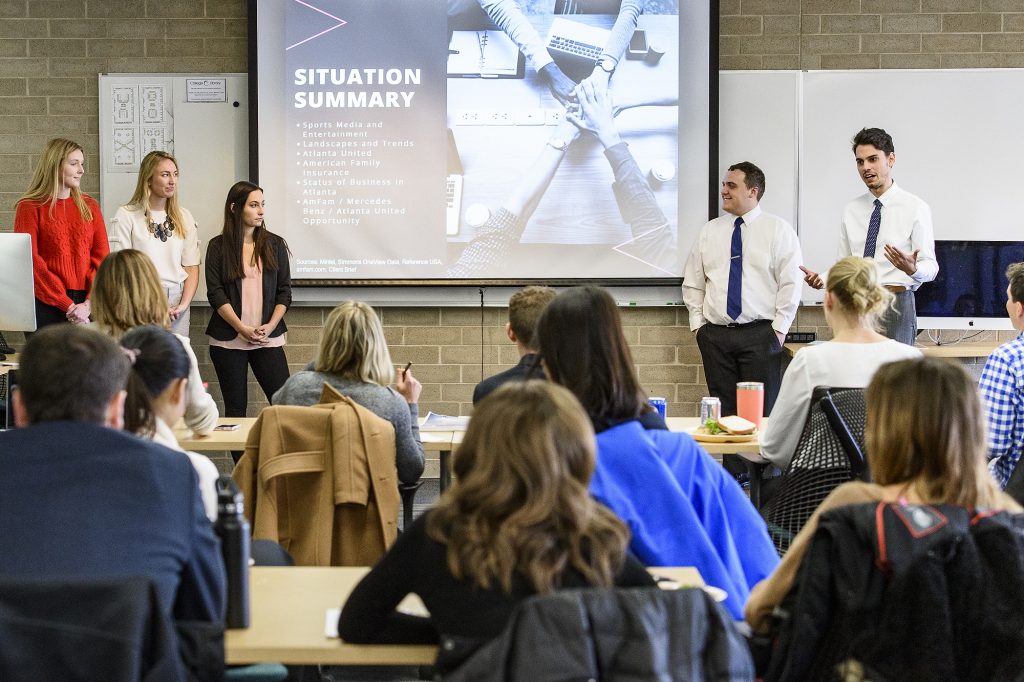
By Emily Knepple
As the fall semester winds down, journalism students are gearing up for hands-on final projects.
J335: Principles and Practices of Reporting is a course offered to students who have successfully completed J202 and J203, the required introductory courses for all J-Schoolers. J335 focuses entirely on reporting, serving as a pillar course of the reporting track within the journalism major.
This semester, there are two sections for undergraduate students, taught by Pat Hastings and Matt Hermann. Adam Schrager teaches a third section, only available to students in the professional track MA program.
J335 gives students the opportunity to explore different media to tell a story. By reading and analyzing stories, students are able to pick up helpful techniques and can identify different aspects of news writing.

“The class is a lot less of me lecturing and more students looking at examples and analyzing, thinking critically,” says Hastings. Through this collaborative effort, students get to know one another and by the end of the semester, the classroom begins to mirror a newsroom.
Hastings emphasizes that the class itself “exposes people to how to package information or new stories.” It also makes students think about how to create the most effective story for their audience.
The course also teaches students the importance of pitching. Hermann says without an accepted pitch, you don’t have a story. The practice of pitching makes students think about what is newsworthy and also illustrates the role of the editor in a real-life newsroom.

Much of the work in J335 requires students to think about what makes a good story. Hermann describes it as getting “students to think a little bit harder about what makes for good, doable stories, wherever they happen to be.” Now that students are back in person, they have the chance to consider a more local frame, which Hermann points out can be where the most important stories are.
Junior Nick Bruesewitz is in Hastings’ J335 class and is double-tracking in the J-School. Bruesewitz, who has a passion for sports, describes 335 as a fun course that has strengthened his reporting skills. In particular, Bruesewitz shares that he’s done a lot of interviewing, which is something he knows he will have to do in his professional career. As someone who enjoys meeting new people, 335 has made Bruesewitz’s return to in-person class one filled with interaction.
“In particular, the classroom setting of 335 has been very much like a think-tank type sharing of ideas, interactive, classroom versus what we’ve had in COVID particular, which was online,” said Bruesewitz.
In the pro-track section of the class, students revisit fundamental concepts but it allows them to sharpen skills they might not have looked at in awhile. “I’ve worked as a journalist, but this class has helped me come back to the basics and make myself both a better researcher and writer,” said Lydia Slattery, who is in her first year of the pro-track program.
For J335 final projects, students work together as a class to write stories under the umbrella of a specific topic. This year, in Hastings’ section, Bruesewitz describes the topic as a “tale of two cities.” Students will look at the reality of life in Madison, compared to the described reality in recent accolades, such as being ranked the “#1 Best Place to Live in 2021” by Livability. Hastings’ describes the project as an online magazine made up of different components. In Hermann’s section, students are giving a voice to an often underrepresented group of people: the disabled community.
“I hope they have developed a somewhat sharper sense of both newsworthiness and the ingredients for an effective story over the course of the semester,” said Hermann.

J345: Principles and Practice of Strategic Communication serves a similar role for students in the strategic communication track within the J-School. Taught this semester by Pete Long and Kate Christy, the course teaches the basics of campaign strategy and uses real-life examples to illustrate the complexities of the process.
“J345 is a special course in the way we introduce critical frameworks, concepts and models to eager but largely inexperienced communicators and facilitate their immediate application of these tools in true-to-life simulated scenarios that mimic the work many of the students will go on to do full-time during their professional careers,” said Long.
Now that students are back in-person, J345 creates an interactive atmosphere. According to Long, the class itself “flourishes when questions, opinions and insights can be shared with physical proximity.”
Students in J345 are able to put their skills to the test with a project that breaks off the class into mock ad agencies. Students “define, develop and refine a final client campaign book over the course of the semester,” that ultimately leads up to a nine-minute pitch to the class.

Roles within agencies are divided into research, account strategy, creative, media and public relations and recently, the course has added a “dedicated social media role that reflects the overarching shift paid media budgets have taken toward paid social and digital advertising, as well as influencer relationships,” shared Long.
Ann Kerr, who is a junior studying strategic communication, as well as Digital Studies and Business certificates, shares that this course has taught her numerous skills she will carry with her into her career.
For the final project, Kerr’s team has been working on creating a mock campaign for Viva Paper Towels. “I am currently the Account Director which has taught me how to effectively manage a team, create a cohesive campaign and keep the brand at the forefront of my thinking,” said Kerr.
Students in both J335 and J345 are working collaboratively on final projects that put the skills they’ve learned this semester into practice.